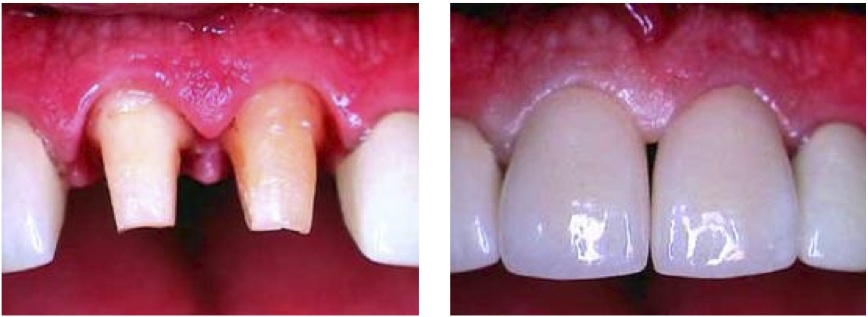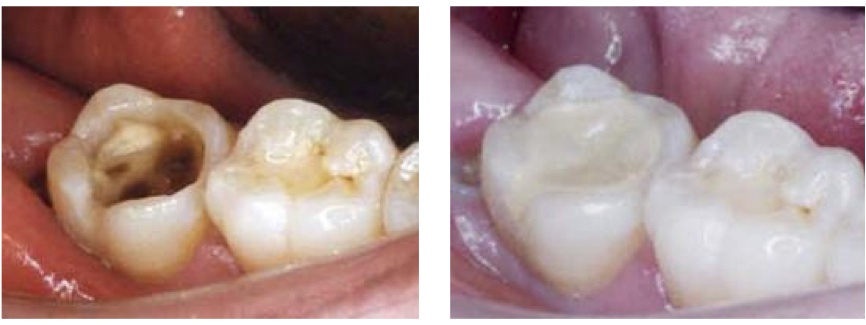
What is a crown and how is it made?
A crown or cap is like a shell that fits over the tooth it is cemented or bonded into place Crowns are an ideal restoration for teeth, which have been broken, or have been weakening by decay or by placing a very large filling. Root treated teeth may require a crown to protect the remaining tooth. A dental crown is a tooth-shaped “cap” that is placed over a tooth. The cap restores the tooth’s shape and size, strength, and appearance.
The crowns, when cemented into place, cover the visible portion of a tooth
The crowns, when cemented into place, cover the visible portion of a tooth
What are crowns made of?
Crowns are made of a variety of materials and new materials are constantly introduced on the market. Different materials are used for different procedures.
Metals used in crowns include gold, palladium, nickel, or chromium. Metal crowns rarely chip or break, last the longest in terms of wear down, and only require a small amount of tooth to be removed. They can also withstand biting and chewing forces. The metallic color is the main drawback. Metal crowns are a good choice for out-of-sight molars.
• Porcelain-fused-to-metal dental crowns can be matched to the color of the teeth beside them. They have a more natural tooth color. However, sometimes the metal under the crown’s porcelain cap shows through as a dark line. Other drawbacks are that the crown’s porcelain portion can chip or break off and there is more wearing down of the teeth opposite them in the mouth. (The top and bottom teeth that come into contact when the mouth is closed.) These crowns can be a good choice for front or back teeth.
• All-resin dental crowns are less expensive than other crown types. However, they wear down over time and are more likely to break than porcelain-fused-to-metal crowns.
• All-ceramic or all-porcelain dental crowns provide the best natural color match than any other crown type. They are also a good choice for people with metal allergies. However, they are not as strong as porcelain-fused-to-metal crowns. They also may wear down the teeth opposite them in the mouth a little more than metal or resin crowns. All-ceramic crowns are a good choice for front teeth.
• Pressed ceramic crowns have a hard inner core. They replace the metal liner that is used in the all-ceramic crown-making process. Pressed ceramic crowns are capped with porcelain, which provides the best natural color match. They are also more long-lasting than an all-porcelain crown.
• Porcelain-fused-to-metal dental crowns can be matched to the color of the teeth beside them. They have a more natural tooth color. However, sometimes the metal under the crown’s porcelain cap shows through as a dark line. Other drawbacks are that the crown’s porcelain portion can chip or break off and there is more wearing down of the teeth opposite them in the mouth. (The top and bottom teeth that come into contact when the mouth is closed.) These crowns can be a good choice for front or back teeth.
• All-resin dental crowns are less expensive than other crown types. However, they wear down over time and are more likely to break than porcelain-fused-to-metal crowns.
• All-ceramic or all-porcelain dental crowns provide the best natural color match than any other crown type. They are also a good choice for people with metal allergies. However, they are not as strong as porcelain-fused-to-metal crowns. They also may wear down the teeth opposite them in the mouth a little more than metal or resin crowns. All-ceramic crowns are a good choice for front teeth.
• Pressed ceramic crowns have a hard inner core. They replace the metal liner that is used in the all-ceramic crown-making process. Pressed ceramic crowns are capped with porcelain, which provides the best natural color match. They are also more long-lasting than an all-porcelain crown.
Porcelain and composite crowns
these crowns are made of a resin material and can look very natural. They are not as strong as bonded crowns and are used as a” long term” intermediate solution for full mouth reconstruction cases. These crowns help the patient to get used to a repositioning of the bite.
Gold and Precious metal crowns
Gold and palladium crowns are very strong and hard-wearing and are usually used at the back of the mouth. They are nor visible and most suitable for people who grind and clench their teeth.
How is a crown made?
The tooth will be prepared for the ideal shape of the crown. This will involve removing most of the outer surface of the tooth leaving a core. The thickness of the crown will be the same as the amount of tooth that has been removed. Crowns are usually made over 2 appointments which are 2 – 3 weeks apart. It may also require an appointment at the laboratory.
Once the tooth is shaped an impression of the prepared tooth will be taken and one of the opposite jaw and another to mark the way you bite. All the impressions will be sent to the technician to reproduce a crown that fits the tooth. A visit to the laboratory will be needed to match the color of the crown to the existing teeth. The prepared tooth will have a temporary crown fitted until the new crown is ready.
How long will a crown last?
The life of a crown depends on how much pressure is applied to the bite and how well it is looked after. The crown can not decay, but decay can start where the edge of the crown joins the tooth. It is very important to keep the gums and crown clean.
The usual procedure for fitting a crown involves shaping the tooth under local anesthetic and then taking an impression using a rubber-like material. The impression is then sent to the laboratory along with the details of the shade to be used, where the technician makes the crown.
What happens to my teeth whilst the crown is being made?
While your crown is being made, the prepared tooth can be protected with a temporary crown, which is easily removed just before fitting the permanent one. In most cases, the temporary crown is in place for about two weeks later.
What are crowns made of?

There are different types of crowns, the most popular being ‘white’ or tooth-colored. These are usually made entirely of porcelain, which can be quite thin and ideal for the front teeth. They can also be made of porcelain bonded to precious metal, which is much stronger and ideal for back teeth.
Crowns can also be made from metal alloys. gold crowns are suitable for back teeth, where they need to be strong enough to stand up to heavy chewing pressure, but the appearance is often not so important. Gold crowns have the advantage of being made very thinly and are often used on teeth that bite together particularly closely.

